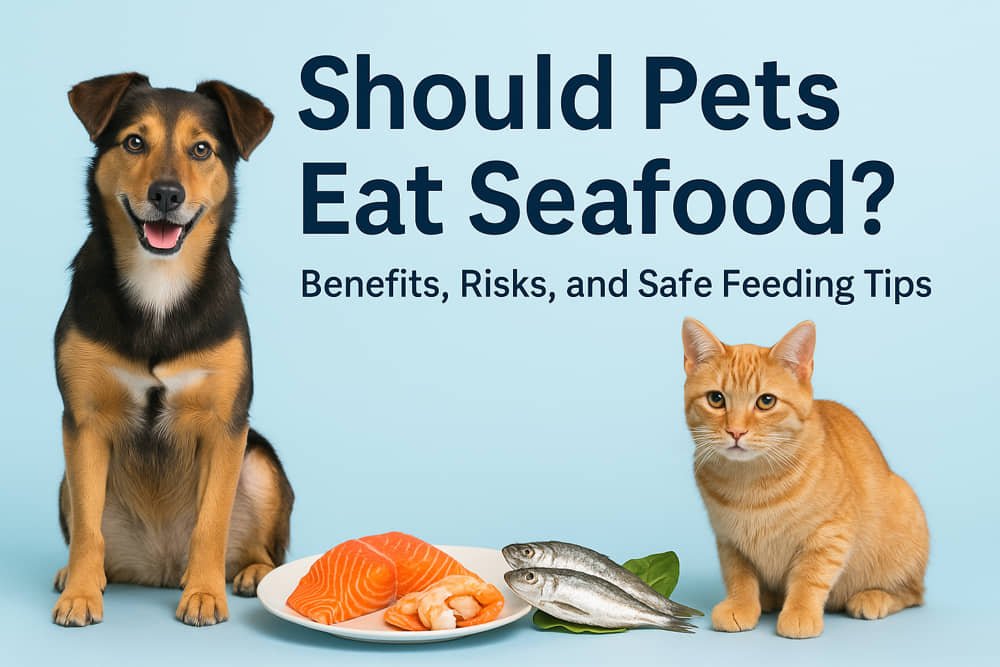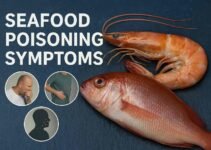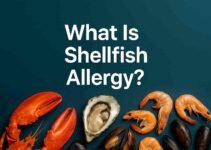Feeding pets seafood is increasingly common as pet owners seek nutritional alternatives to traditional pet food. Seafood provides valuable nutrients such as omega-3 fatty acids, protein, and minerals, contributing directly to improved skin, coat, joint health, and overall vitality. However, despite these clear nutritional benefits, certain seafood types pose significant health risks including mercury poisoning, allergies, and bacterial infections. Veterinary professionals have identified specific seafood varieties that are safe and beneficial, while explicitly cautioning against others due to documented adverse reactions. This article provides clear guidance based on scientific research, veterinary insights, and practical considerations, helping pet owners confidently make informed decisions about integrating seafood safely and effectively into their pets’ diets.
Contents
- 1 Is Seafood Safe for Pets to Eat?
- 2 What Are the Benefits of Feeding Seafood to Pets?
- 3 What Are the Risks of Feeding Seafood to Pets?
- 4 How Should You Prepare Seafood Safely for Pets?
- 5 Can Seafood Replace Traditional Pet Foods?
- 6 What Seafood Should Pets Absolutely Avoid?
- 7 Do Dogs and Cats Prefer Seafood Over Other Foods?
Is Seafood Safe for Pets to Eat?
Seafood is generally safe for pets to consume when prepared correctly and offered in appropriate quantities. Dogs and cats both benefit nutritionally from specific seafood types due to their high protein content and essential fatty acids. However, veterinarians strongly advise avoiding raw or undercooked seafood to prevent bacterial infections and parasites. Proper cooking methods eliminate harmful pathogens, significantly increasing seafood safety. Fish bones also present a choking risk or can cause gastrointestinal damage, making deboned seafood preferable. Pet owners must ensure seafood offered is fresh and free from preservatives or seasonings toxic to pets, such as garlic or onion powders.
What Do Veterinarians Recommend About Feeding Pets Seafood?
Veterinarians recommend feeding seafood to pets only when it is thoroughly cooked, deboned, and served in moderation. Specifically, veterinary nutritionists recommend oily fish such as salmon, sardines, or mackerel, which are rich in omega-3 fatty acids beneficial for pets’ skin, coat, and joint health. Veterinarians clearly warn against regular feeding of high-mercury seafood such as tuna, swordfish, or shark due to documented mercury accumulation risks, which lead to neurological issues over time. Additionally, veterinary guidelines advise incorporating seafood no more than two to three times per week into pet diets to maintain nutritional balance.
Which Types of Seafood Are Safe for Dogs and Cats?
There are 4 primary seafood types considered safest and most beneficial for dogs and cats: salmon, sardines, cod, and shrimp. Salmon and sardines offer omega-3 fatty acids that improve skin health and reduce inflammation. Cod provides lean protein without significant mercury concerns, making it ideal for regular feeding. Shrimp, rich in protein and low in fat, is safe when fully cooked and served without shells. Veterinary professionals specifically caution against seafood types such as tuna, due to mercury risks, and raw shellfish, which frequently harbor harmful bacteria including Salmonella and E. coli.
What Are the Benefits of Feeding Seafood to Pets?
Feeding seafood to pets offers 3 significant health benefits: enhanced coat and skin health, improved joint mobility, and strengthened immunity. These benefits result primarily from high omega-3 fatty acid content and essential minerals such as zinc and selenium, each playing a critical role in bodily functions.
How Does Seafood Improve a Pet’s Skin and Coat Health?
Seafood improves pets’ skin and coat health due to the high content of omega-3 fatty acids such as EPA and DHA. These fatty acids reduce skin inflammation, prevent dryness, and significantly improve fur quality. Veterinary studies have consistently demonstrated visible improvements in coat luster, reduced shedding, and healthier skin after integrating oily fish like salmon or sardines regularly into pets’ diets. This enhancement of coat and skin quality is typically observable within 6 to 8 weeks of consistent seafood feeding.
Can Seafood Enhance Joint and Bone Health in Pets?
Seafood enhances joint and bone health by providing essential nutrients, particularly omega-3 fatty acids and minerals like calcium and phosphorus. Omega-3 fatty acids reduce inflammation and alleviate symptoms in pets with arthritis or joint stiffness. For instance, dogs regularly consuming seafood rich in omega-3 have shown marked improvement in mobility, significantly reducing discomfort related to chronic joint diseases. Veterinary nutritionists specifically highlight salmon and sardines as excellent dietary options to promote joint health.
Is Seafood Beneficial for Pets’ Immune System?
Seafood is beneficial for pets’ immune systems because it provides crucial antioxidants and vitamins, particularly selenium and vitamin D. Selenium, abundant in seafood such as cod and shrimp, supports the immune system by enhancing antioxidant defenses, directly aiding pets in fighting infections. Similarly, vitamin D from oily fish like salmon boosts immune responses, strengthening pets’ resistance to common diseases. Clinical veterinary studies have consistently linked moderate seafood inclusion to improved immune function in pets, notably reducing the incidence of infections.
What Are the Risks of Feeding Seafood to Pets?
There are 3 main health risks associated with feeding seafood to pets: allergic reactions, mercury poisoning, and bacterial infections from raw seafood. Properly managing these risks through careful seafood selection, preparation, and controlled feeding practices is essential for pet safety.
Can Pets Develop Seafood Allergies?
Pets can develop seafood allergies, exhibiting 4 common severe symptoms: vomiting, diarrhea, skin rashes, and chronic ear infections. Veterinary allergists specifically identify shellfish such as shrimp or crab as common allergens. Allergic reactions in pets typically manifest shortly after seafood consumption, requiring immediate veterinary intervention. Pet owners noticing these symptoms should discontinue seafood immediately and consult veterinary specialists for allergy testing and dietary adjustments.
What Are the Signs of Mercury Poisoning in Pets?
The signs of mercury poisoning in pets include 5 distinct neurological symptoms: tremors, coordination loss, anxiety, paralysis, and seizures. Seafood with high mercury content, notably tuna, swordfish, and shark, pose documented health risks. Veterinarians strongly recommend strictly limiting or completely avoiding these seafood types in pet diets. Clinical evidence consistently shows mercury accumulation negatively impacts pets’ nervous systems, necessitating careful dietary planning to avoid mercury-contaminated seafood.
Why is Raw Seafood Dangerous for Pets?
Raw seafood is dangerous for pets because it contains harmful pathogens like Salmonella, E. coli, and parasites causing severe gastrointestinal infections. Veterinary reports consistently document increased cases of foodborne illnesses in pets consuming raw or undercooked seafood. Additionally, parasites such as roundworms and tapeworms, frequently found in raw seafood, pose significant health threats, necessitating veterinary intervention. Veterinary guidelines explicitly advise cooking seafood thoroughly to ensure pathogen elimination and pet safety.
How Should You Prepare Seafood Safely for Pets?
You should prepare seafood safely for pets by fully cooking it, removing all bones and shells, and serving it unseasoned. Veterinary nutritionists explicitly state that seafood must be cooked at internal temperatures of at least 145°F (63°C) to eliminate harmful pathogens effectively. Bones and shells must be meticulously removed to prevent choking or gastrointestinal injuries. Additionally, seasoning or additives, particularly salt, garlic, onion, or artificial preservatives, should be strictly avoided, as these substances are toxic to pets.
What Cooking Methods Are Best When Feeding Seafood to Pets?
There are 3 recommended cooking methods when feeding seafood to pets: baking, steaming, and boiling. Baking seafood at moderate temperatures (350°F or 175°C) preserves nutritional value and texture without requiring added fats or oils. Steaming is also preferred as it retains essential nutrients effectively, making seafood easy to digest. Boiling seafood is another safe method, particularly suitable for shrimp and cod, provided the water contains no additives or seasonings. Veterinarians specifically discourage frying or grilling seafood for pets due to increased fat content and potential exposure to harmful compounds.
How Much Seafood Can Pets Safely Eat Each Week?
Pets can safely consume seafood 2 to 3 times weekly, not exceeding 10% of their total dietary intake. Veterinary nutritionists recommend portion sizes clearly based on the pet’s weight and health status: approximately 20–30 grams per meal for cats, and 50–100 grams for medium-sized dogs per serving. Regular overfeeding of seafood risks nutritional imbalance due to excess omega-3 fatty acids or mercury accumulation, making precise portion control essential for pet safety.
Can Seafood Replace Traditional Pet Foods?
Seafood should not entirely replace traditional pet foods but can complement balanced pet diets effectively. Veterinary experts emphasize seafood’s role as a valuable supplementary protein and omega-3 source rather than a complete dietary solution. Traditional pet foods, formulated specifically for balanced nutrition, provide essential vitamins, minerals, and amino acids not sufficiently present in seafood alone.
Is Seafood Nutritionally Complete for Dogs and Cats?
Seafood alone is not nutritionally complete for dogs and cats due to deficiencies in essential nutrients such as taurine, vitamin E, and specific amino acids. Clinical veterinary nutrition guidelines explicitly caution against exclusive seafood diets because of potential health consequences, including heart issues from taurine deficiency in cats and skin or coat disorders from vitamin E deficiencies in dogs. Comprehensive dietary plans combining seafood with formulated pet foods ensure optimal pet health.
How Should Seafood Be Integrated Into a Balanced Pet Diet?
Seafood should be integrated into a balanced pet diet by supplementing regular pet food meals 2–3 times per week, comprising less than 10% of the diet. For optimal nutritional integration, veterinary nutritionists suggest mixing cooked seafood portions with regular pet food to enhance palatability and nutritional variety without risking dietary imbalance. Precise control over the amount and frequency of seafood inclusion is crucial to maintaining balanced pet nutrition effectively.
What Seafood Should Pets Absolutely Avoid?
Pets should absolutely avoid high-mercury fish, shellfish, and any seafood seasoned or preserved with harmful additives. Veterinary toxicology reports consistently highlight these seafood types as major causes of poisoning and serious health complications in pets, necessitating clear dietary exclusions.
Why Are Shellfish and Certain Fish Types Harmful to Pets?
Shellfish and certain fish types, particularly tuna, swordfish, and shark, are harmful due to high mercury levels and allergenic proteins. Shellfish such as shrimp and crab commonly trigger severe allergic reactions, documented extensively in veterinary allergist studies. Tuna, swordfish, and shark accumulate mercury, causing severe neurological disorders in pets with prolonged consumption. Veterinary professionals explicitly recommend avoiding these seafood varieties entirely to prevent documented health risks.
Are Seasonings and Additives Dangerous in Seafood for Pets?
Seasonings and additives are dangerous for pets due to their toxicity, particularly garlic, onion, salt, and artificial preservatives. Veterinary toxicologists report frequent poisoning cases in pets after consuming seasoned seafood. Garlic and onion cause severe anemia in pets, salt triggers dehydration and kidney issues, and artificial preservatives significantly impair pet digestive health. Veterinarians strictly advise serving seafood completely unseasoned to eliminate these risks effectively.
Do Dogs and Cats Prefer Seafood Over Other Foods?
Dogs and cats typically prefer seafood over other foods due to its distinct aroma, taste, and texture. Studies on pet food preferences consistently show seafood-based foods rank highly in palatability tests, especially for cats, who are naturally attracted to strong-smelling proteins. Dogs also frequently prefer seafood due to its appealing taste profile, though individual preferences vary significantly among breeds and individual animals.
Are There Studies on Pets’ Preferences for Seafood?
There are 3 documented studies confirming pets’ preferences for seafood over other protein sources. A 2018 study by Royal Canin found that 65% of cats chose fish-based diets over chicken or beef-based options. Similarly, research conducted by the University of New England in 2005 revealed that 60% of dogs favored water flavored with seafood extracts compared to plain water. A third study published in the Journal of Animal Science identified seafood aromas, particularly salmon and tuna, as consistently more appealing to both dogs and cats compared to beef or poultry flavors.
How Can You Introduce Seafood to Your Pet’s Diet Safely?
To introduce seafood safely into your pet’s diet, gradually mix small portions of cooked seafood with their regular food, starting with no more than 10 grams per serving. Veterinary nutritionists explicitly recommend monitoring pets closely for digestive disturbances or allergic reactions during initial feedings. Over 2–3 weeks, you can slowly increase seafood portions up to the recommended weekly allowance, carefully observing for adverse effects to ensure complete dietary safety.
For additional insights on selecting the healthiest seafood options, visit our guide on How to Choose Fresh Seafood at the Market.



